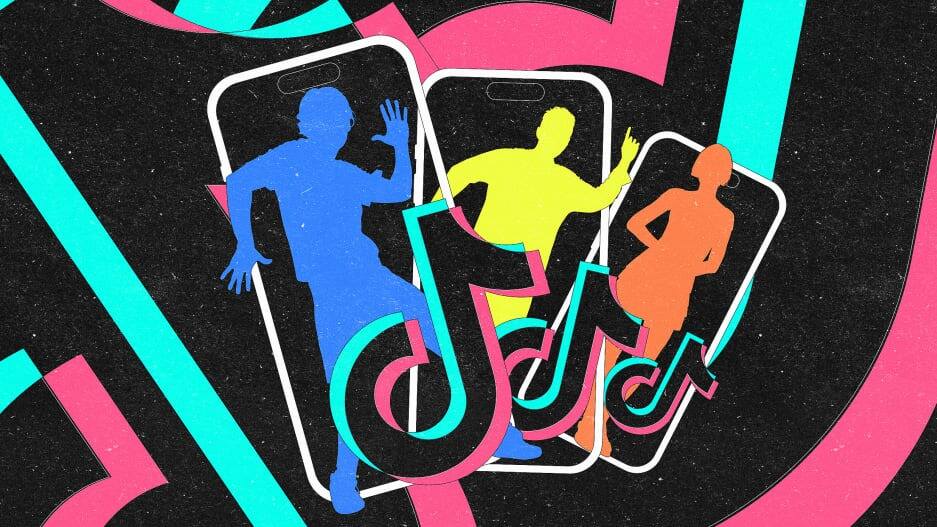- | 9:00 am
How TikTok’s pushy watermark boosted its brand—and hurt Instagram
TikTik’s logo has become one of the most recognizable in digital culture—thanks in part to competitors who inadvertently promoted it.

Branded is a weekly column devoted to the intersection of marketing, business, design, and culture.
As a rule, no business wants to become a distribution tool for its greatest rival.
But that’s what happened to Instagram early in its struggle to be more competitive with TikTok. Reels, its answer to TikTok, was regularly being used to repurpose videos that were not only made for TikTok, but actually included a TikTok “watermark,” consisting of a logo and user name. In effect, Instagram was promoting its competition.
Instagram-parent Meta made moves to fix this problem: It announced that the company had “heard” that “content that is visibly recycled from other apps (i.e. contains logos or watermarks) makes the Reels experience less satisfying,” and was thus making rival-branded videos “less discoverable.”
But the issue persisted and has again resurfaced, thanks to a Wall Street Journal report drawn partly from a recent, leaked internal document, “Creators x Reels State of the Union 2022.” This document noted that “nearly one-third of Reels videos are created on another platform, usually TikTok, and include a watermark or border identifying them as such,” according to The Journal. While Instagram’s algorithm “downranks” these clips, limiting their audience, recycled videos apparently remain a nagging problem. (In some cases, this involves unscrupulous users reposting other creators’ videos.)
Clearly, this just compounds Instagram’s most acute challenge these days: For some time now, it’s been roundly criticized and mocked for morphing into more and more of a shameless copycat. TikTok creators have poked fun at Reels as an also-ran format with clueless users, and famously the Instagram celebrity mega-influencers Kylie Jenner and Kim Kardashian endorsed a call to “make Instagram Instagram again” and “stop trying to be TikTok.” (Although TikTok has lately been doing some copycatting of its own.) So the effort to encourage original—or at least not blatantly recycled—Reels content has become increasingly crucial to protecting Instagram’s brand.
But it’s worth noting that this isn’t all just about what Instagram has done wrong. It’s also a tribute to TikTok’s success in pushing its own brand. That pushy little watermark—including a simplified version of its logo that wiggles around—stays onscreen throughout any given TikTok by default. This could have been judged annoying, given the often-busy design of many TikToks, but it seems to have been accepted without complaint. And over time, it has surely made the service’s logo one of the most recognizable in digital culture.
After all, that internal Meta report noted that TikTok users spend a combined 197.8 million hours a day looking at videos on the app (compared to Instagram users’ 17.6 million hours viewing Reels). This reflects TikTok’s rapid growth to more than 1 billion users, with revenue estimated to hit $12 billion this year, thanks to increasing ad sales. TikTok’s watermark sticks around when a clip gets tweeted or embedded elsewhere. That’s quite a bit of exposure to a brand’s mark. And in what could be read as an acknowledgment that watermarks are a vital branding tool in the short-form video wars, YouTube recently announced that YouTube Shorts clips—that’s YouTube’s TikTok/Reels competitor—will be marked with an icon to signal its origin if it gets picked up on another platform.
Notably, the TikTok mark itself hasn’t changed much in the half-dozen years since the company was founded: The logo remains a stylized glyph resembling a music note (reflecting the app’s music-and-lip-sync roots), rendered in white with teal and red trim, lending a 3D-like effect against a black background. “The designer was inspired by a rock concert with a dark hall and a stage lit up,” according to the site of brand identity firm Logaster. The result does what may be a logo’s most important job today: stand out on the home screen of your phone. And the simple but distinct shape remains legible even in tiny, monochrome form in a watermark.
That said, much of the success of any given logo boils down to raw repetition and exposure. And the way that TikTok has executed that task has surely made things harder for Meta. It’s been widely noted that Facebook and Instagram have effectively cloned a rival format before, with what amounted to a version of Snapchat’s “stories” that the services didn’t even bother to rename. Clearly pulling off something like that again is going to be much more of a challenge this time—and those logo-ed watermarks are one reason.
That is what’s giving Instagram such a headache right now. (Meta has said that the leaked internal report is not fully up-to-date with latest data and has been taken out of context, but has conceded that the company has “work to do” with Reels.) The company is reportedly upping the financial incentives for creators to make Instagram-specific, or at least Instagram-led, content. But even that effort just risks underscoring TikTok’s dominance.
Still, in a sense, TikTok has default-branded not just all the zillions of videos made and distributed through its platform, it branded an entire genre of addictive, short-form clips, in effect. That’s why the first problem Instagram has to avoid is the risk that it gets definitively branded, too—as just another place to see TikToks.





































